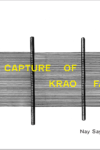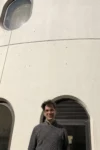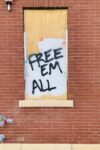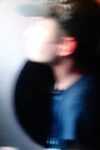This interviews comes in two parts, the first of which was published last week and can be read here.
Paige Parsons: The sense of danger is really palpable. I’m thinking about how we feel disassociated from these data profiles, and they’re being built in the background as we navigate data collection points in our daily lives—sometimes carelessly, like I click yes to cookies all day. But I feel like in the writing itself here, you’re both creating coherence in these character’s stories and also dispersing that patterning.
Jena Osman: One thing I’m interested in related to what you just said is that I’m trying to disperse patterning, I think that’s a really good way to phrase it. The patterns are the problem, right? In literature you can disrupt the patterns, and offer new ones. I don’t really think there’s a way to be outside of the patterns, but there can be new options for sense-making and for how one uses the information that one has. I’m making connections that wouldn’t normally be made, with the idea that this could allow for a kind of attention to the world that could change something. When you stop being in a position of interrogatives, that’s when you get set in these repetitious negations.
What I would hope to do, in all of my books, is to approach these topics from the place of being an amateur. I’m not an expert in any of these things that I’m fascinated by, and I’d like to think that this amateur lens is what allows me to see things in a slightly different way and make connections that someone who is an expert wouldn’t be able to make because it’s outside the paradigm. A lot of the poetry that I’m interested in, these hybrid works that mix genres, is trying to mix up how one might normally think about particular kinds of subject matter.
I appreciate how, in the second piece, “Popular Science,” you also act out for the reader how your own mind is going towards categorization and a “laziness,” specifically with the moment when you start looking for the physical locations of the phrenological institute. I really like that that moment of push and pull is in the text, of resisting your own seduction into this categorizing system.
A lot of the work in that piece had to do with arrangement, like how to put materials side by side so that there could be a measuring of one kind of knowing against another kind of knowing. I’m interested in how these 19th century texts that I’ve been referring to have such a particular kind of certainty, a relationship to certainty in which the truth can be known that I really can’t fathom having now. There is something very positive in that knowledge, seemingly, though at the same time you had systems of knowing, such as the phrenological systems, that were very dehumanizing and reflected a lot of racist and classist presumptions. I wanted to put that unproblematized belief in a certain truth up against the contemporary belief that we can know everything through some kind of algorithmic total information awareness. Everyday there’s a different story related to this quest; this week it was all about the facial recognition algorithms that police departments want to use. There are just so many possibilities for your identity to be collected and tabulated. On the one hand, people believe we need this, it’s for security, but on the other hand wait a second, these algorithms are totally error prone and the consequences are really serious. Questioning those desires for certainty alongside one another felt like an important thing to do.
In the last essay, I am curious about the “I might” refrain and the impulse towards orderliness. What sparked your interest in the Wagner Institute specifically?
Philly has these great nineteenth-century small museums, like the Mutter Museum and the Athenaeum and the Wagner Free Institute of Science–small strange places that have these beautifully preserved displays of nineteenth-century thinking. The Wagner is up by Temple, and I think because of its location it just doesn’t get visited very often, but also, the way that Wagner endowed it, they didn’t really have to do any public-facing fundraising until quite recently I think. The neighborhood changed around it, and now it’s in this weird Temple development zone. When you go in there, everything is almost exactly as Wagner arranged it, with his handwritten labels and wooden display cases. You open up a drawer and there are stuffed birds. The idea of collecting nature in this way and building a structure for it is just so profoundly weird. And still, you go to the Museum of Natural History and the display is so much part of how we interpret what has happened and what exists, so I wanted to put an emphasis on that, to a certain degree.
I wanted to learn more about William Wagner, but I couldn’t find much about him by looking into the museum’s archives. I’m not a historian and I’m sure some historian out there could get a better sense of who he was as a person, but I was using the clues that I could find, and trying to figure out what his life was like, what determined his life and his decision to collect. His collecting began when he was working for Stephen Girard, who was, and I think still is, the second richest man ever in the United States (because he figured out how to exploit trade patterns with his ships). Wagner was going around the world and collecting the world in this particular way in order to present information: this is the truth, these are the facts.
And presenting it to the public, through seminars as well.
And they still do free science classes in the museum.
I was interested in how you brought up being in Philadelphia today and listening to conversations about education tax cuts on the radio, and how disparate this kind of educational moment seems from the free science classes at the museum.
But also connected, like if the government can’t provide, then we the wealthy of the city will provide education for the masses. When you put that up alongside charter schools, and thinking about how all the things he was collecting, like coral, are really endangered now, the things that we teach haven’t really been altered even though the ground beneath us is really altering. I wanted to put those systems up against each other and see what happened.
What poets first sparked your engagement with poetry—I know we talked before the interview about your time at Oberlin in the 80s, which at the time had a fairly mainstream approach to poetry—who is still important to you from then?
Once I left college, and went to grad school, I was trying to catch up on things that I wasn’t aware of. I had some classmates, including the poet Elizabeth Robinson, who pretty much just said you should read these people. One of the writers was Leslie Scalapino, whose work has been important to me since that time. Her work is suffused with contemporary events, but they are presented at the same level and pitch as these very surreal, gorgeous images, so you’re in a world that’s of this world and not of this world and it’s all on the same plane. She also did experiments with genre, in my mind connected to things that Gertrude Stein did, really asking you to think about what makes this a poem as opposed to a play as opposed to an essay. At that time she was making a lot of things that she was calling comic books, with no images, but creating this sense of frames that are side by side, so formally—on the level of image and language—she was very influential. I was and still am very influenced by her work.
Susan Howe is also someone who is extremely important to me, again in how she works with essay and poem, and visuality and deep history. And she’s also working through archives and acknowledging her process of working through these materials, which becomes a launch pad into these pretty radical experiments with language. She’s huge for me.
What are you reading right now that you’re excited by?
Zahra Patterson’s Chronology.–I love the various materials, the approach to personal experience through archive, and the book itself is a very gratifying object with inserts that function as footnotes. I also recently read a book by Paisley Rekdal called Intimate. It’s about Edward Curtis, who photographed the “old West,” and about his Native American assistant Alexander Upshaw, and also about her parents who were mixed race. The pattern of the book is a poem, a section in the voice of Curtis, bolded sections that are in the voice of Upshaw, and then these other sections that are the narrative about her family. All of these parts are woven together. There are photos and meditations on photography throughout. I was really interested in how these materials worked together.
I’ve been thinking a lot about photography lately, and I’m also really interested in Hardly War by Don Mee Choi, which is an amazing book. Her father was a war photographer in Vietnam and Korea so she’s thinking about photography in particular ways, but also thinking about nation. I’m not going to do the book justice because it’s so rich in the connections it’s making between language and image and translation and nation. They’re all very hybrid works. I’ve kind of lost my ability to read poems, what one of my students described as “poem-y poems,” where it’s just kind of in a lyric square. I am just really drawn to these works that branch into other art-forms and are allowing different kinds of writing to exist together.
There’s something so nice about sitting down with a book and getting to move between forms. I liked that when I was reading Motion Studies. It’s nice to feel that you have this density before you, and you’re learning. What is that drive for you to need more mediums?
The essay form is something I’m drawn to because there’s a sensation that I’m taking in information in a way that’s about knowing, whereas poetic form is often about not-knowing. I like to toggle between those two feelings, and I find that oscillation very generative for me as a reader. Again, it’s back to Brecht—one minute, you’re laughing and enjoying and engaging, and the next minute you’re stepping back, judging, thinking critically, and trying to figure out whether it could be otherwise—having those two feelings side by side, back and forth. When I was in school, there was so much rhetoric about what it means to activate the reader, how we want the reader to be active, not passive, and thinking about what that really means. For me, that’s where action is. If you’re asked to think in two different ways side by side, I can feel it, almost in my body, this activation. I can never be lulled, it’s not like listening to a song from beginning to end and thinking, that’s beautiful. It’s more that I’m always changing my relationship to the text because the text keeps asking me to change my relationship to it.
What are you working on now?
I have a couple of projects on the backburner—one is about text and textiles and translation. It’ll be kind of an artist book and an exhibition when it’s done, and it entails using a jacquard digital loom and Google Translate.
That’s often how it works. I know that I’m fascinated with something, and I know that there’s something in there that I need to unlock, but I don’t know what it’s going to be until I really start working with it.

Jena Osman’s books of poems include Motion Studies (Ugly Duckling Presse), Corporate Relations (Burning Deck), Public Figures (Wesleyan University Press), The Network (Fence Books, National Poetry Series selection), An Essay in Asterisks (Roof Books), and The Character (Beacon Press, winner of the 1998 Barnard New Women Poets Prize). Osman was a 2006 Pew Fellow in the Arts, and has received grants for her poetry from the National Endowment for the Arts, the New York Foundation for the Arts, The Pennsylvania Council on the Arts, the Howard Foundation, and the Fund for Poetry. She co-founded and co-edited the literary magazine Chain with Juliana Spahr from 1994-2005.
Paige Parsons is a writer from southern California. She lives in New York where she apprentices at Ugly Duckling Presse.
This post may contain affiliate links.







